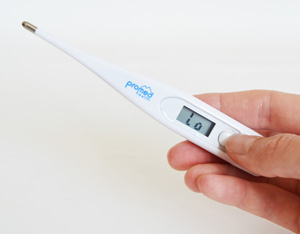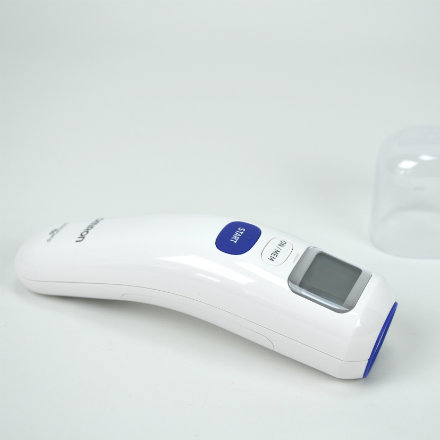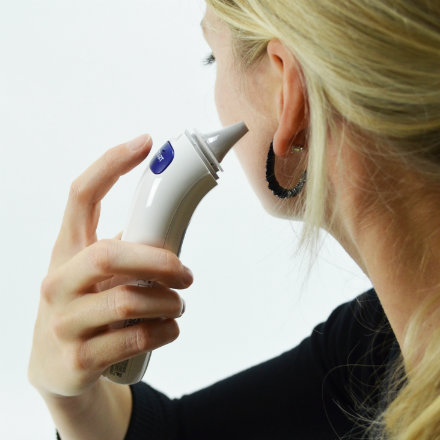Today's digital thermometers do not require much effort in order to be able to read the temperature within a very short time. You can opt for a classic digital thermometer, which measures the temperature in the armpit, the ear, the mouth or the anus. Then there are also non-contact infrared thermometers for recording the temperature of the forehead. When you measure someone's temperature you have to note the location of the measurement, as it will have an impact on the result because the value for fever changes, depending on where you are measuring. The normal temperature value, and thus the point where fever 'starts', is as follows:
• on the forehead - measured with a forehead thermometer: 35.8 °C to 37.6 °C (96.44-99.68 °F),
• in the ear - measured with an ear thermometer: 36.0 °C to 37.8 °C (96.8-100.04 °F),
• rectally - measured with a conventional thermometer: 36.3 °C to 37.8 °C (97.34-100.04 °F),
• orally - measured with a conventional thermometer: 36.0 °C to 37.4 °C (96.8-99.32 °F).
It is also useful to understand that certain factors can significantly affect the body temperature of a healthy person. Among these are the individual metabolism, clothing, the outside temperature and also age. The body temperature of infants and young children is, for example, higher than that of adults. Body temperature generally decreases with age.
The time of day also makes a difference. In the morning, body temperature is lower and rises towards the evening. Physical and mental activity can have an effect on body temperature as well as food and fluid intake. Therefore it is recommended not to drink or eat immediately before to a temperature measurement in order to avoid distortion of the results.
Depending on the clinical thermometer you are using, there are additional factors that you should consider. Cerumen can, for example, affect the result of temperature measurement in the ear. You should therefore clean your ear properly before using an ear thermometer. When it comes to axillary measurement, you should ensure to clear the armpit of sweat and that the fever thermometer should sit well in place.
If you have a thermometer, use it only at the intended location: a forehead thermometer only for the measurement on the forehead, an ear thermometer only for the measurement in the ear and so on. Since depending on the location, the temperature results differ, you cannot really compare the results of two different thermometers. Always inform your doctor about the kind of thermometer you were using on which part of your body.
Wellnessproducts > Fever measurement
Things to note when measuring feverMost clinical thermometers nowadays are designed in a way to provide a comfortable, accurate and easy measurement. Clinical thermometers with mercury gauges belong in the past and have been replaced by digital thermometers. Nevertheless, there are certain things to consider in order to achieve the most accurate measurements.
 What are the benefits of non-contact clinical thermometers?Among the main advantages of non-contact thermometers are they are intrinsically hygienic and that a patient does not need to be woken up for a temperature measurement. This is also why contactless thermometers are often used in clinics and hospitals. They enable rapid temperature measurements to be taken without the need to disinfect the device afterwards. Families with babies or small children can benefit from a non-contact thermometer as well, since they can let the child sleep and still measure the temperature. Furthermore, many infrared thermometer are also able to measure the temperature of objects (e.g. baby bottles) and the room temperature. You thus have a multi-function thermometer at hand that you can use not only for fever measurement.
Measurement with a non-contact infrared thermometer also does not require much time or effort. Once you switch it on, it will signal that it is ready for measurement after a short time. You can then hold the thermometer at a distance of about 2-5 cm from the measuring point (e.g. forehead). Press 'start' and wait for the beep that signals the end of the measurement. Depending on the type of thermometer, it may be good to slowly move the thermometer over the forehead. At the end of the measurement, you can read the value and benefit from the storage function to be able to compare the measured values. Published on 17.09. by  Fever measurement without skin contact Fever measurement without skin contact Infrared thermometers offer a very quick and precise measurement of the body temperature, with no need to wake up the patient or to touch him.  Thermometer Thermometer Measuring the body temperature gives you important information for being able to monitor the course of the desease. With these thermometers you receive quick and reliable results. |
- FREE DELIVERY (ECONOMY)
- Safe shopping: Payment with TWINT, credit card, Paypal or Postfinance
- Warehouse in Switzerland (Widnau SG)

